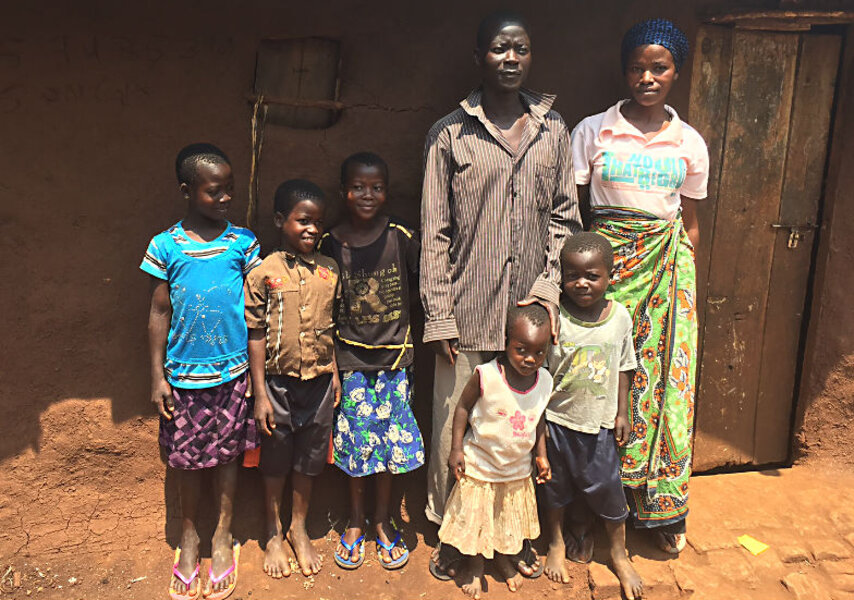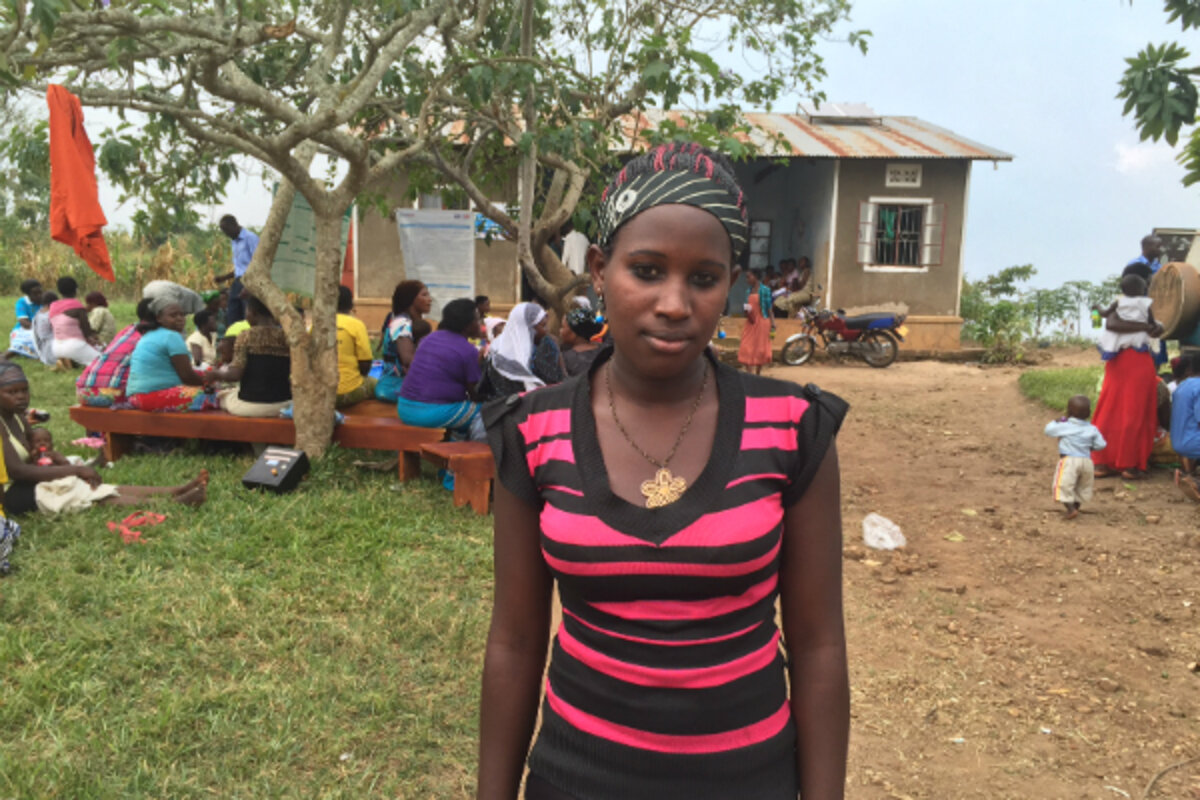Why Uganda’s teenage girls could hold key to its prosperity
Loading...
| Gomba, Uganda
Farming is not the future that Prossy Nakalema envisioned for herself when she graduated from high school earlier this year – an accomplishment that remains more extraordinary than mundane for girls in this East African country.
A stylish 18-year-old whose woven braids match her pink-and-black outfit, Ms. Nakalema dreams of going to college, getting a good job, and putting off what most of the young women around her accept as the normal future: a string of babies to tend to by one’s mid-twenties.
But her family has no extra income to send her on to college, and her months-long job hunt has come up dry, so Prossy is stuck on her family’s small plot not far from the shores of Lake Victoria. With every day, she feels her hopes of overcoming a future of young motherhood and subsistence farming receding.
“I’m just digging,” she says of her daily farming chores. “Digging, and that’s it.”
Nakalema’s plight – and the challenge it illustrates of the untapped potential of young women and girls – is just one of the problems that Uganda faces as it struggles to lift itself from least-developed status into the ranks of Africa’s middle-income countries. As in other places, corruption and inefficient public institutions – poor and inadequate schools, a deteriorating health system – are part of what holds Uganda back.
But Uganda faces a particular impediment: a stubbornly high birth rate, and the prospect of seeing a population of 38 million nearly triple by 2050. That’s because the average young Ugandan woman like Nakalema is still producing nearly six children, a fertility rate only surpassed by a handful of poorer African countries.
With an extraordinary 70 percent of the population under 25 – and more than one-third under 10 – Uganda has no chance of achieving middle-income status unless birth rates are cut sharply, and quickly, experts say.
“No country on Earth has ever become a middle-income country with this level of population growth,” says Mark Meassick, mission director in Uganda for USAID, the US government’s humanitarian and development assistance agency. “It will not happen.”
Official dialogue is shifting
The government of President Yoweri Museveni is showing some signs of shifting away from a traditional “the more babies the better” outlook on population growth. Mr. Museveni, who has been in power for 30 years, has for the first time made a series of commitments under the United Nations’ family-planning agenda.
Issues like birth control, adolescent birthrates, and the role of women and girls in economic development are inching into the government’s public dialogue. That is a milestone for this deeply religious (85 percent Christian) and socially conservative country perhaps best known for a harsh 2014 anti-homosexuality law.
“Just the fact that we Catholics are now talking about family planning is progress enough,” says Ronald Kasyaba, a doctor and officer with the Uganda Catholic Medical Bureau, a major provider of health services in the country.
Also wielding strong influence in Uganda are the powerful American conservative Christian groups that feed skepticism about international family-planning efforts, often by associating those efforts with abortion, which remains illegal in Uganda.
But others warn that attitudes and behavior are not changing nearly fast enough to permit Uganda’s economic rise to the level of a country like next-door-neighbor Kenya, whose lower-middle-income status Ugandans aspire to.
“The government is evolving on family planning, but not fast enough,” says Mr. Meassick. “There’s still the idea that the more children, the more consumers of Ugandan products, the better.”
Foreign donors fund family planning activities
The evolution in official thinking on family planning and population growth has not translated into more robust budgetary support for related programs and services.
Instead, what has developed is an unspoken division of labor under which foreign aid donors, including the US, underwrite the lion’s share of the country’s family planning activities – everything from urban clinics to rural “pop-up” services offering consultations and medical procedures to prevent pregnancies. The government, meanwhile, focuses on economic development through large infrastructure projects like dams, major highways, and even a new railroad.
“We are making progress. The declining fertility rate from 7.1 in 2001 to 5.8 now tells you we’re going in the right direction,” says Jackson Chekweko, executive director of Reproductive Health Uganda, a nongovernmental reproductive health services and policy advocacy organization in Kampala. “But the government is still leaving family planning to the [foreign] donors,” he says “because they know the donors will do it.”
Visiting Uganda’s reproductive health clinics – many carrying the distinctive logo of their principle source of funding, USAID – or walking Kampala’s slums with community-outreach volunteers is enough to make one realize that attitudes are nevertheless changing.
Women still talk about hiding an interest in contraception from a resistant husband, or wonder about rumors they hear that using a birth control method will leave them unable to bear children later. But the large crowds that flock to family-planning consultation days in rural areas suggest Ugandan women are by and large a few steps ahead of the government.
“Having more children than you can afford to keep in school is no longer modern,” says Harriet Nakiganda, a mother of twins who had a tubal ligation and now volunteers at a rural clinic in Gomba district southwest of Kampala.
Teen pregnancies remain high
A primary focus of Uganda’s family-planning efforts is on adolescent girls that many say hold the key to success in the country’s race to defuse the ticking population bomb. But by many measures the statistics on adolescent girls in Uganda are worrisome.
Teen marriages and teen pregnancies remain high even by regional standards, while many economists warn that the sharp drop-off of girls’ enrollment in school after primary education will continue to impede Uganda’s rise out of least-developed status.
“Fifty-nine percent of school dropouts are due to unwanted pregnancy,” says Frederic Mubiru, project manager in Kampala for FHI 360, an international human development organization. “It’s all girls, and it’s a significant number.”
Another warning sign for Uganda is the recent spike in the number of adolescent girls testing positive for HIV – indeed adolescent girls comprise the only population group in the country experiencing a rise, rather than a decline, in HIV infections.
One explanation for the rise, experts say, is the growing phenomenon of girls with few skills and poor economic prospects turning to older men or “sugar daddies” to support them and their families.
Such worrisome trends underscore the urgency for Uganda of ramping up its attention to adolescent girls and young women – to make it possible for high school graduates like Prossy Nakalema to go to high school and on to college, put off having children, and play a role in building the country’s prosperity.
Keeping children in school
Another key to Uganda’s aspirations for rising to middle-income status will be mothers like Prossy Namukwaya, who farms alongside her husband on their small plot of land in Kayunga district east of Kampala. Women in Kayunga, a largely rural district with a large Muslim population, still have an average of seven children.
Ms. Namukwaya and her husband, Abdu Nasuba, have managed to keep three of their four children in school. But now they’ve taken in the child of a sister of Namukwaya who recently died. While they want the children to stay in school until they graduate, they are not sure how long they can keep paying the bills.
“I want them in school, the girls and the boys, but I’m not sure how long we could afford it on the crops,” she says, referring to the corn and beans she has always grown.
And so the couple with five kids in a typical two-room earthen hut have each recently added a new activity they hope will generate new income for the family: he, making bricks, she, raising eucalyptus seedlings for sale to nearby tree nurseries.
“My goal was always to space my children so I would have time to add some income to our family and give our children a better life,” she says. Gesturing to the modest rows of spring-green seedlings behind her, she says, “I’m hoping those little trees will help us keep our children in school.”
Reporting for this story took place while the reporter was on a UN Foundation Press fellowship.







